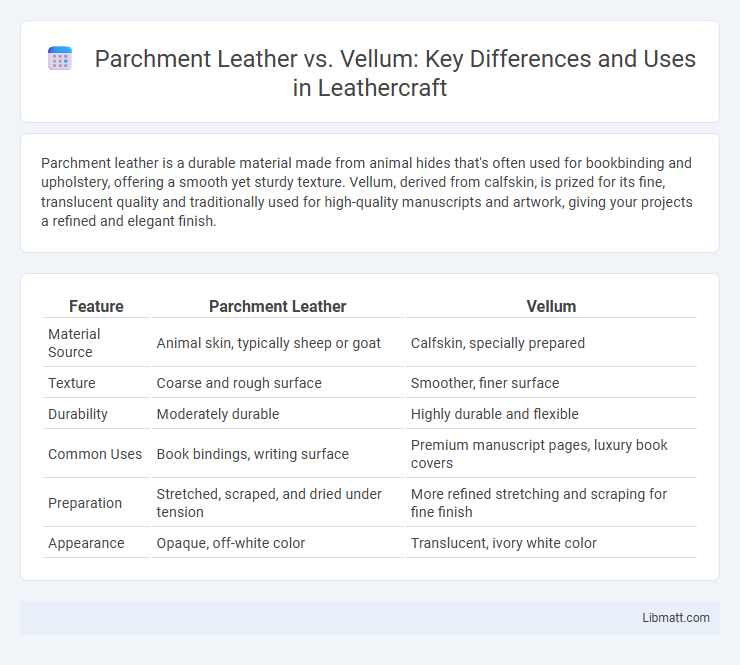Parchment leather is a durable material made from animal hides that's often used for bookbinding and upholstery, offering a smooth yet sturdy texture. Vellum, derived from calfskin, is prized for its fine, translucent quality and traditionally used for high-quality manuscripts and artwork, giving your projects a refined and elegant finish.
Table of Comparison
| Feature | Parchment Leather | Vellum |
|---|---|---|
| Material Source | Animal skin, typically sheep or goat | Calfskin, specially prepared |
| Texture | Coarse and rough surface | Smoother, finer surface |
| Durability | Moderately durable | Highly durable and flexible |
| Common Uses | Book bindings, writing surface | Premium manuscript pages, luxury book covers |
| Preparation | Stretched, scraped, and dried under tension | More refined stretching and scraping for fine finish |
| Appearance | Opaque, off-white color | Translucent, ivory white color |
Introduction to Parchment, Leather, and Vellum
Parchment is a writing material made from specially prepared animal skins, typically sheep or goats, renowned for its smooth surface and durability. Leather, derived from tanning animal hides, serves primarily in fashion, furniture, and accessories due to its flexibility and strength. Vellum, a finer form of parchment usually made from calfskin, offers a higher quality texture preferred historically for manuscripts and art, making it ideal for preserving Your important documents with elegance.
Historical Evolution of Parchment and Vellum
Parchment and vellum both originated in ancient Mediterranean cultures, initially crafted from animal skins to serve as durable writing surfaces. Vellum, typically made from calfskin, was prized during the Middle Ages for its fine grain and smooth texture, often used in illuminated manuscripts and religious texts, while parchment, made from sheepskin or goatskin, was more commonly utilized for everyday documents. The historical evolution of these materials transitions from early papyrus and wax tablets to sophisticated parchment preparation techniques, reflecting advancements in medieval book production and archival preservation.
Material Sources: Animal Origins Compared
Parchment leather is made from the treated skins of sheep, goats, or calves, offering durability and flexibility ideal for bookbinding and writing surfaces. Vellum, a finer quality form of parchment, specifically originates from young calves, providing a smoother and more delicate texture favored for luxury manuscripts and archival documents. Your choice between parchment leather and vellum depends on the required texture and strength derived from their distinct animal origins.
Production Techniques: Parchment vs Vellum
Parchment is made from the skin of sheep or goats, involving a process of cleaning, stretching, and drying the skins under tension to create a durable writing surface. Vellum, on the other hand, is crafted from calfskin, which undergoes a similar but more meticulous preparation, resulting in a finer and smoother texture preferred for high-quality manuscripts. Your choice between parchment and vellum depends on the desired texture and durability, with parchment being more common and vellum offering a premium finish.
Physical and Visual Differences
Parchment leather is thicker and more textured with a coarser surface compared to vellum, which is smoother, thinner, and more translucent. Vellum has a creamy white color and a fine grain that creates an elegant, uniform appearance, while parchment leather exhibits natural irregularities and a matte finish. The physical durability of parchment leather is higher due to its dense fiber structure, whereas vellum is more delicate and prone to damage from moisture and handling.
Durability and Conservation
Parchment leather offers superior durability due to its treatment process, making it more resistant to wear and environmental factors compared to vellum, which is more delicate and prone to deterioration over time. Conservation of parchment leather involves less frequent restoration efforts, while vellum requires careful humidity and temperature control to prevent warping and brittleness. Both materials benefit from archival storage conditions, but parchment leather's enhanced resilience makes it preferable for long-term preservation in historical documents and manuscripts.
Uses in Art, Manuscripts, and Documents
Parchment leather, made from animal hides, is robust and ideal for creating durable covers and binding materials in art and manuscript preservation. Vellum, crafted from calfskin with a finer texture, serves as a preferred surface for high-quality illuminated manuscripts and detailed calligraphy due to its smooth finish. Both materials are essential in historical documents, with parchment leather often used for covers and vellum for the writing surface, ensuring longevity and aesthetic appeal.
Cost and Accessibility
Parchment leather tends to be more expensive than vellum due to its complex tanning and finishing processes, making it less accessible for everyday use. Vellum, often derived from calfskin, is generally more affordable and widely available, appealing to artists and calligraphers seeking quality materials at a lower cost. The availability of vellum in various thicknesses and finishes enhances its accessibility compared to niche parchment leather products.
Modern Applications and Alternatives
Parchment leather is commonly used in luxury bookbinding and high-end stationery due to its durability and texture, while vellum, traditionally made from calfskin, remains preferred for archival documents and fine art prints because of its smooth surface. Modern applications have expanded to include digital printing substrates and custom notebook covers, with synthetic alternatives like synthetic parchment and vegan leather providing cruelty-free, eco-friendly options. These materials offer similar aesthetic qualities with enhanced resistance to wear and environmental factors, meeting contemporary demands for sustainability and performance.
Choosing Between Parchment Leather and Vellum
Choosing between parchment leather and vellum depends on your project's durability and texture needs. Parchment leather offers a supple, resilient surface ideal for long-lasting bookbinding and luxury accessories, while vellum provides a smooth, translucent finish favored for fine art and calligraphy. Evaluating your use case will help you select the material that best balances aesthetic appeal and functional performance.
Parchment leather vs vellum Infographic

 libmatt.com
libmatt.com